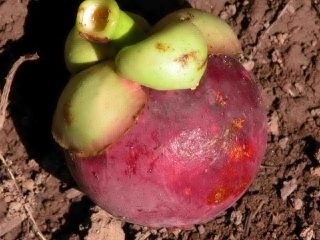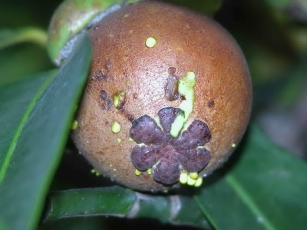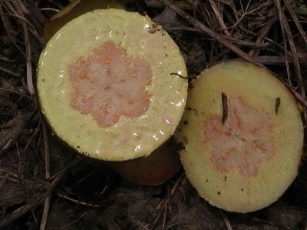
www.mangosteen.com

introduction
What is a mangosteen


Young mangosteen fruit weeks Ripe mangosteen. It starts to turn
away from full ripeness. a Dark purple color next
The mangosteen is a fruit originating in Southeast Asia. It is considered a member of the plant family Clusiaceae (see the SCIENCE, NON-SCIENCE AND NONSENSE section of this site) although it is often in earlier works referred to as a member of the Guttiferae family. The latin name for the mangosteen is Garcinia mangostana L. and the genus Garcinia is an honor bestowed upon Laurent Garcin by Linnaeus for his work as a botanist and naturalist in the 18th century. The mangosteen as a fresh fruit is in great demand in its native range and is savored by all who find its subtle flavors a refreshing balance of sweet and sour. It should be pointed out that Asians consider many foods to be either 'cooling' such as the mangosteen or 'heating' such as the durian depending on whether they possess elements that reflect yin and yang. This duality is commonly used to help describe balance in many aspects of life in general and food in particular throughout Asia.

The mangosteen, queen of tropical fruit. In the background, the
durian, "king of fruit."
See the informative page on the Wikipedia site at http://en.wikipedia.org/wiki/Yin_and_yang for a much more thorough explanation of this important aspect of Asian philosophy.
Outside of the mangosteen's native range, the fruit is considered exotic. There are some large plantings in Lancetilla, Honduras as a result of an early introduction by the United Fruit Company. There are also plantings of various sizes in other Latin American countries including Brazil, Costa Rica, Panama and at the experimental stations in the tropical parts of Central and South America. There is an excellent reference to the movement of the mangosteen (see References below) written in 1915 by Wilson Popenoe, a protege of David Fairchild. It provides an early framework of the distribution attempts made. At the time of the article, Popenoe was Director of Agricultural Experiments at United Brands.
The difficulty in obtaining plant material and satisfying stringent tropical cultural requirements is just the beginning of trying to introduce a new fruit such as the mangosteen. One must also have the financial resources and patience to be able to endure the very long term growth period to first fruiting and then the additional years to commercial quantities. Commercial levels of production take a minimum of ten to fifteen years. And then of course there is the critical issue of complying with agricultural shipping restrictions at your location if you are to export. All of these factors conspire to force even greater constraints on availability of the mangosteen. The intent of this site is to inform consumers outside of the mangosteen's native range of the extraordinary qualities of this fruit as availability gradually improves in the years to come.
The popularity of the mangosteen in its native range has resulted in it being planted as a dooryard or backyard tree or in small plantations and then harvested for local consumption. The few remaining wild trees in Borneo, Malaysia, Thailand, Brunei Darussalam, Indonesia and other Asian countries are sought out and fruits are collected for the markets in towns of the region. The usual method is to climb the tree or use ladders to avoid letting the fruit hit the ground or be handled roughly during the harvest. The bright yellow and very astringent latex which occurs throughout the tree trunk, stems, leaves and developing fruit can enter the edible white portion of the ripe fruit with any undue pressure on the rind of the mangosteen during picking.


The bright yellow latex or sap of the mangosteen can enter the edible portion, making it bitter
This is not only a cosmetic problem; the latex is quite bitter and makes the fruit much less enjoyable or even inedible. There is also a related disorder called gamboge which seems to be worse during some years than others and can ruin a large percentage of a given year's crop. The intrusion of latex may in some cases be disease-related but there is evidence that a series of environmental conditions may also increase the amount of affected fruit. The continuity of rainfall and the associated high humidity during the ripening period are critical to bring the mangosteen to full maturity. It is possible that a drop in humidity (usually but not always during a break in the rainfall) causes the developing mangosteen rind to start hardening prematurely. Then a subsequent resumption of rainfall may force the latex into the from the rind into the edible segments within the now less elastic interior of the fruit. This destructive internal pressure may also cause the appearance of translucence in fruit sections near the seeds in the very delicate segments. The latex or sap may also ooze through the rind and appear as hardened yellow droplets on the outside of the fruit (see above photo). Seeing these droplets does not automatically ensure that the fruit will be bad, however. They can appear on the outside for a variety of reasons unrelated to gamboge, leaving the fruit inside unscathed.
The latex or sap of the mangosteen has played a long-term role as a black coloring agent and has been used for centuries to dye silk. I mention this because care must be taken to keep the mangosteen sap off your clothes. It stains fabric and may also linger on your hands for some time as well.
The other pages of this web site get into greater detail and are as follows: history and folklore; science, non-science and nonsense; how to open and enjoy the mangosteen and Acknowledgements. Combined, they attempt to provide a starting point for the curious who stumble upon this site in search of an overview of this most extraordinary fruit, the mangosteen. In addition, there are several pages of photographs (The Photo Gallery) that show the earliest stages of mangosteen production, from seedling all the way to fruit production.
The history and folklore section took longer than all the other pages as the articles and books cited are scattered all over the globe and cover a time frame of centuries.
The Science, non-science and nonsense page is entirely the result of the recent upsurge of interest in mangosteen-related processed products of all types. As with many new products, there is much hype and little true relevant science but this will hopefully change in the future. Until that time, all processed mangosteen products should be considered recreational, not essential and not truly medicinal in value. Not a substitute for proper medical care or a substitute for any prescribed medications, either. Fortunately, many sites make this clear. A supplement should be just that... supplemental.
REFERENCES
Popenoe, Wilson. The mangosteen in America. Jour. of Hered. Vol. VI, No. 8, Aug 15., pages 339-347. 1915